
NBA Legends
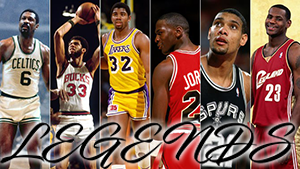 Many dominant talents have come and gone over the 70-plus years of the National Basketball Association, evolving the game along the way.
Many dominant talents have come and gone over the 70-plus years of the National Basketball Association, evolving the game along the way.
The NBA recognized many of those players during its 50th-anniversary season in 1996 when it unveiled its famous list titled “NBA at 50: Top 50 Players.” Unfortunately, the league hasn’t come out with another authoritative list since then, leaving it up to media members, bloggers, and fans to debate and rank which players since then also deserve mention as the greatest of all time.
But while greatness is one thing, legendary status is another. In this article, we’ll identify the 35 players we consider to be the greatest legends to ever grace the hardcourt of the NBA.
What Makes a Player an NBA Legend?
There are no hard-and-fast rules that anyone can apply to determine whether a player is a legend or not. Compiling a list of NBA legends is a completely arbitrary task, and a legendary player in one person’s eyes may not be a legendary player in another’s.
In our opinion, the use of the word “legend” to describe an NBA player should be limited as much as possible. After all, if you refer to too many players as legends, it minimizes the significance of actually being on the list. In other words, it means far less to be mentioned in a list of 100 players than it does to be included on a list of 25.
Therefore, we’ve been very discretionary in compiling this list of the greatest NBA legends of all time. Not only were we looking for the best players of their generations, but we also applied the criteria of players who left an indelible mark on the game. Winning a lot of championships or scoring a lot of points over a career doesn’t necessarily make you a legend in our mind. We focused more on men who revolutionized the sport, whether it be redefining how certain positions were played, forcing the league to make rule changes to limit their dominance, ranking among the all-time best in various statistical categories, or how their legacy extended off the court following their retirement as players.
With that in mind, here is our list of the 35 greatest NBA legends of all time (in no particular order), along with an explanation of why each of them deserves inclusion on this hallowed list.
The 35 Greatest NBA Legends of All Time
- Michael Jordan
- Kareem Abdul-Jabbar
- Wilt Chamberlain
- Magic Johnson
- Larry Bird
- Kobe Bryant
- Julius Erving
- LeBron James
- Bill Russell
- Hakeem Olajuwon
- Jerry West
- Tim Duncan
- Bob Cousy
- Oscar Robertson
- Isiah Thomas
- Steve Nash
- Allen Iverson
- Ray Allen
- Dwyane Wade
- Shaquille O’Neal
- Dirk Nowitzki
- James Worthy
- Pete Maravich
- Bill Walton
- Moses Malone
- Karl Malone
- John Stockton
- Jason Kidd
- Rick Barry
- Dominique Wilkins
- Elgin Baylor
- Kevin Garnett
- Charles Barkley
- Steph Curry
- Reggie Miller
Michael Jordan
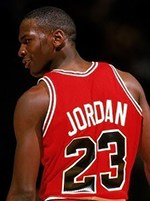 Declaring any player to be the best ever to play their sport usually makes for an intense debate in sports bars, but Jordan is the exception to the rule. The NBA’s own website defines Jordan as “the greatest basketball player of all time,” and it’s virtually impossible to disagree.
Declaring any player to be the best ever to play their sport usually makes for an intense debate in sports bars, but Jordan is the exception to the rule. The NBA’s own website defines Jordan as “the greatest basketball player of all time,” and it’s virtually impossible to disagree.
Jordan’s legacy isn’t limited to the six consecutive NBA championships he won with the Chicago Bulls in the 1990s (not counting the 1994 and 1995 seasons, which he took off in order to pursue a career in professional baseball), his five NBA MVPs, his 14 all-star nominations, or his legendary competitive spirit at both ends of the floor. MJ’s marketability, charisma, and explosive athleticism made him an international icon, whether it was as Nike’s Air Jordan or as a star in the movie Space Jam. Not bad for a guy who was famously cut from his high school varsity team!
There are simply too many incredible accomplishments in Jordan’s career to cover all of them in this space. But whether you’re too young to have been able to witness his greatness or you’re interested in a fun walk down memory lane, here are just a few of the thrilling moments MJ provided NBA fans that will last forever:
Game 6 of the 1998 NBA Finals
In his final game with the Bulls, Jordan almost single-handedly delivered Chicago the last of its six championships during the 1990s. Not only did MJ provide the title-clinching basket on a jumper from the top of the key with 5.2 seconds left, but he also stole the ball on Utah’s previous possession to set up the winning shot. Jordan’s last-minute heroics punctuated a 45-point effort as he played all but four minutes of the contest in the high altitude of Salt Lake City.
Game 5 of the 1997 NBA Finals
In the wee morning hours of June 11, 1997, Jordan woke up in a profuse sweat and suffering from flu-like conditions. After calling a trainer to his hotel room, it was determined that MJ was either suffering from a stomach virus or food poisoning, and he was essentially ruled out of that night’s critical Game 5 in Utah. But with his Bulls badly needing a victory after Utah had won the previous two games to tie the series 2-2, Jordan got out of bed roughly one hour before tip-off and went on to lead the Bulls to a 90-88 triumph. Not only did His Airness play 44 minutes that night, but he also led all scorers with 38 points – including 15 in the fourth quarter, helping Chicago overcome a late eight-point deficit.
Game 5, First Round of the 1989 NBA Playoffs
Of the 25 game-winning shots that Jordan delivered throughout his career, none was bigger than the dagger he hit at the final buzzer on May 7, 1989. With his Bulls trailing the host Cleveland Cavaliers 100-99 in the fifth and deciding game of the first round of the playoffs, Jordan took an inbounds pass with three seconds left on the clock, shook a double-team of defenders, and drained an off-balance shot over Cleveland’s Craig Ehlo to give Chicago a 101-100 victory. Although the Bulls didn’t win their first NBA title of the Jordan era until two years later, many consider “The Shot” to be the moment in which the Bulls dynasty was born. [ Back to Top ↑ ]
Kareem Abdul-Jabbar
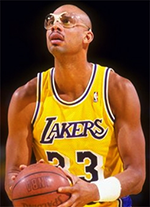 The basketball artist was formerly known as Lew Alcindor (his birth name before he converted to Islam at the age of 24 and legally changed his name), Abdul-Jabbar’s place atop the NBA’s all-time scoring list will almost certainly be secure forever. Kareem’s combination of longevity, durability, and a dominant skyhook enabled the graceful center to score 38,387 points throughout his 20-year career, nearly 5,000 more points than iconic scorers like Jordan and Kobe Bryant.
The basketball artist was formerly known as Lew Alcindor (his birth name before he converted to Islam at the age of 24 and legally changed his name), Abdul-Jabbar’s place atop the NBA’s all-time scoring list will almost certainly be secure forever. Kareem’s combination of longevity, durability, and a dominant skyhook enabled the graceful center to score 38,387 points throughout his 20-year career, nearly 5,000 more points than iconic scorers like Jordan and Kobe Bryant.
Though some may point to the length of Abdul-Jabbar’s career as the biggest reason for his massive scoring numbers (he’s also third of all time in rebounds and blocks), Kareem didn’t just stick around to pad his stats. He still averaged 23 points per game when he was 38 years old, and he was named an all-star in 19 of his 20 seasons with the Milwaukee Bucks and Los Angeles Lakers.
Six NBA championships and six MVP awards further cement his status as one of the NBA’s greatest legends. [ Back to Top ↑ ]
Wilt Chamberlain
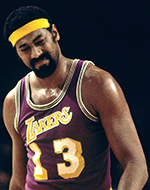 At 7-foot-1 and approximately 300 pounds, Chamberlain was the most imposing specimen the NBA had ever seen when he entered the league in 1959. His unprecedented size helped him dominate the center position throughout his 14-year career, highlighted by his 100-point performance for the Philadelphia Warriors in a 1962 game against the New York Knicks. To this day, Wilt the Stilt remains the only player in NBA history to crack the century mark in a single contest, the league’s all-time leader in rebounds, and the only player to score 4,000 points in a single season.
At 7-foot-1 and approximately 300 pounds, Chamberlain was the most imposing specimen the NBA had ever seen when he entered the league in 1959. His unprecedented size helped him dominate the center position throughout his 14-year career, highlighted by his 100-point performance for the Philadelphia Warriors in a 1962 game against the New York Knicks. To this day, Wilt the Stilt remains the only player in NBA history to crack the century mark in a single contest, the league’s all-time leader in rebounds, and the only player to score 4,000 points in a single season.
However, pigeon-holing Chamberlain as a scorer whose success was simply due to his size would not be fair. He displayed offensive finesse with his “Dipper” move (faking a hook shot, then finger-rolling the ball under the block attempts of opponents), he was also annually among the league leaders in assists, and his ability to play defense without fouling was incredible (he never fouled out of a game in 14 years).
Dominance in the paint is what Chamberlain will always be remembered for the most. The league had to make several rule changes in order to minimize his impact on the game, such as widening the lane, implementing offensive goaltending, and even changing rules regarding how balls are inbounded and how free throws were shot. [ Back to Top ↑ ]
Magic Johnson
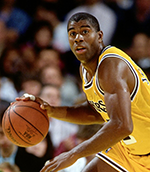 Few (if any) players have ever displayed the combination of excellence, athleticism, sportsmanship, and pure joy that Earvin “Magic” Johnson brought to the court during his 13-year NBA career.
Few (if any) players have ever displayed the combination of excellence, athleticism, sportsmanship, and pure joy that Earvin “Magic” Johnson brought to the court during his 13-year NBA career.
Magic led the Los Angeles Lakers to five NBA titles in the 1980s, was named Finals MVP in three of those victories, and claimed league MVP honors three times in a four-year span from 1987-1990. His career numbers would have been more impressive had he not missed nearly five entire seasons due to a pair of retirements after testing positive for HIV (leading him to bravely become a public advocate for AIDS prevention and safe sex). A more accurate measurement of Johnson’s impact on the court is that he is the NBA’s all-time leader in average assists per game.
What stands out most about Magic is how he revolutionized the point guard position. At 6-foot-9, he remains the tallest player to play the 1-spot in NBA history, and his ability to score, assist, and rebound from that position was something the league had not seen since the days of Oscar Robertson. Former coach Paul Westhead once said it all about Magic’s versatility: “We all thought he was a movie-star player, but we found out he wears a hard hat. It’s like finding a great orthopedic surgeon who can also operate a bulldozer.”
Johnson has remained involved with the NBA in various capacities, including as a television commentator, a head coach, and a part-owner. Today, he serves as the Lakers’ president of basketball operations. [ Back to Top ↑ ]
Larry Bird
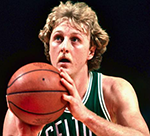 When one of your nicknames is “Larry Legend,” you clearly deserve a spot on any list of NBA greats. The former Celtics power forward simply did it all on the basketball court during a 13-year career that spanned the 1970s, ‘80s, and ‘90s, reflected by the 59 triple-doubles he racked up (seventh-most in history).
When one of your nicknames is “Larry Legend,” you clearly deserve a spot on any list of NBA greats. The former Celtics power forward simply did it all on the basketball court during a 13-year career that spanned the 1970s, ‘80s, and ‘90s, reflected by the 59 triple-doubles he racked up (seventh-most in history).
In addition to averaging 24.3 points, 10 rebounds, and 6.3 assists per game, Bird also shot nearly 50% from the field, was one of the league’s first 3-point specialists, and even collected more than 1,500 steals on defense. Bird is also one of just three players in NBA history to win three consecutive league MVP awards, and he led the Celtics to the NBA title in 1981, 1984, and 1986.
Despite all of his career accolades, Bird’s most incredible feat might have come in a relatively meaningless regular-season game against Portland in 1986. With a game coming up against the LA Lakers two nights later, Bird announced he was “saving (his) right hand for the Lakers” and played the majority of the game against Portland using his off-hand to shoot the ball. Bird went on to shoot 10 for 21 from the field, finishing the game with 47 points, 14 boards, and 11 assists – recording a triple-double with his left hand.
Even after his playing days ended, Bird continues to have a major impact on the NBA. He’s currently the president of the Indiana Pacers, the organization with whom he was named both coach of the year (1998) and executive of the year (2012). In fact, he’s the only man in NBA history to be honored with the league’s MVP, top coach, and top executive awards. [ Back to Top ↑ ]
Kobe Bryant
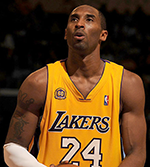 The explosive athletic ability and fiercely competitive spirit that Bryant exhibited as an 18-year-old entering the league out of high school immediately made him the heir apparent to Air Jordan, and Kobe did not disappoint. Though he was named the league MVP just once throughout his 20-year career, Bryant was always among the NBA’s leading scorers (including a pair of season scoring titles) and ranks third in league history with 33,643 points.
The explosive athletic ability and fiercely competitive spirit that Bryant exhibited as an 18-year-old entering the league out of high school immediately made him the heir apparent to Air Jordan, and Kobe did not disappoint. Though he was named the league MVP just once throughout his 20-year career, Bryant was always among the NBA’s leading scorers (including a pair of season scoring titles) and ranks third in league history with 33,643 points.
Bryant always played with a chip on his shoulder, especially after sexual assault allegations in 2003 led to intense criticism from media and fans. In response to that ordeal and in order to help him cope with all the negative attention, Bryant created his own alter ego titled “Black Mamba,” a snake that was used as a code name for a deadly assassin in the movie Kill Bill. “I’m destroying everybody that steps on the court. I had all this pent-up frustration that I just needed to let out… There was nothing that was going to stop me,” Bryant said in Muse, a 2015 auto-documentary of his life and career.
Bryant’s many career achievements include winning five NBA championships and two Olympic gold medals, being the youngest player to ever start in an NBA All-Star Game (he was 19 years old when he started the 1998 midseason classic), claiming four All-Star MVP awards, and scoring 81 points in a 2006 game against Toronto (the second-most in history behind only Wilt Chamberlain). Bryant even concluded his career with a bang, scoring 60 of the Lakers’ 101 points in his final-ever game at the end of the 2016 season. [ Back to Top ↑ ]
Julius Erving
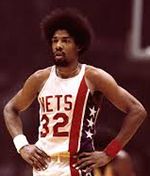 Even though the origin of Erving’s “Doctor J” nickname is unclear, the moniker was perfect for a man who operated on the basketball court with the precision, expertise, and even class of a surgeon.
Even though the origin of Erving’s “Doctor J” nickname is unclear, the moniker was perfect for a man who operated on the basketball court with the precision, expertise, and even class of a surgeon.
You won’t find Erving’s name on the list of the NBA’s top 25 scorers of all time, but don’t let that fool you into thinking he wasn’t one of basketball’s greatest-ever scorers. Doctor J spent the first five seasons of his 16-year pro career in the now-defunct American Basketball Association, and the combined 30,026 points he scored in the ABA and NBA would rank ninth on the NBA’s all-time scoring list as of 2018.
An 11-time NBA all-star who helped the Philadelphia 76ers win the NBA championship in 1983, Erving was best known for his acrobatic dunks. Although Erving lost to Larry Nance in the final of the NBA’s first Slam Dunk Contest in 1984, Doctor J was the champion of the ABA’s dunk contest in 1976 – the first dunking competition held by any professional league.
Not that Erving was a one-trick pony, however. His end-to-end dash and soft underhand scoop for a layup in the 1980 NBA Finals drew awe from fans and opponents alike (the Lakers’ Magic Johnson later said, “My mouth just dropped open… I thought… should we take the ball out or should we ask him to do it again?”) and is remembered to this day as the “Baseline Move.” [ Back to Top ↑ ]
LeBron James
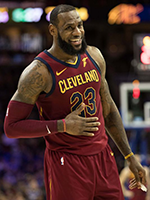 It’s difficult to summarize the career of a player when that career is still going. But King James’ list of amazing accomplishments already merits inclusion on the NBA’s list of all-time legends, even if the final chapters have yet to be written.
It’s difficult to summarize the career of a player when that career is still going. But King James’ list of amazing accomplishments already merits inclusion on the NBA’s list of all-time legends, even if the final chapters have yet to be written.
At the time of writing, LeBron had appeared in seven consecutive NBA Finals with two different organizations, was named NBA Finals MVP in each of his three title wins, was the highest-scoring player in NBA playoff history, and had won four league MVPs. He had also averaged more than 2,000 points per season over his 15-year career, a pace that would allow him to overtake Kareem Abdul-Jabbar for the all-time scoring lead if he played five more seasons.
Despite being saddled with seemingly impossible expectations since he was in high school, LeBron has not only met them but exceeded them in virtually every category. And although he was widely criticized and even vilified for leaving his hometown Cavaliers in 2010 to form a super team with Dwyane Wade and Chris Bosh in Miami, James more than made up for it by returning to the Cavs five years later and delivering a championship to Cleveland’s long-suffering fans in 2016.
James has also embraced his responsibilities as the most famous and influential athlete in North American sports, if not the world. He has never shied away from lending his voice to important causes or weighing in on controversial issues, especially those involving politics or race. [ Back to Top ↑ ]
Bill Russell
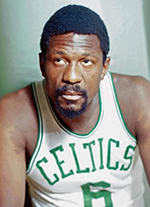 No player in NBA history won as many championships as the former Celtics great, who incredibly captured 11 titles during his 13-year career. In fact, those 11 championships tie Russell for the most won by any athlete in any of the four major North American sports, and Henri Richard needed 20 seasons to win his 11 Stanley Cups in the National Hockey League.
No player in NBA history won as many championships as the former Celtics great, who incredibly captured 11 titles during his 13-year career. In fact, those 11 championships tie Russell for the most won by any athlete in any of the four major North American sports, and Henri Richard needed 20 seasons to win his 11 Stanley Cups in the National Hockey League.
While most NBA legends earned their place in history by posting dominant offensive numbers, Russell’s lasting legacy is solely at the defensive end of the floor. The 6-foot-10 center was renowned for his shot blocking and ferocious man-to-man defending, and he was also one of the greatest rebounders the NBA has ever seen. Russell joins Wilt Chamberlain as the only players to ever grab 50 rebounds in one game, and he ranks second in history in both total rebounds and average rebounds per game.
Russell’s greatness may have been even more appreciated if the NBA had recorded blocks during his playing days (the league began tracking that statistic in 1973, four years after Russell’s retirement), since some believe that Russell averaged more than 10 blocks a game. Since Russell also averaged 15.1 points and 22.5 rebounds per contest, 10-plus blocks per outing would have meant he averaged a triple-double in his career.
In 1980, the Professional Basketball Writers Association of America named Russell the Greatest Player in the History of the NBA. Michael Jordan may have since supplanted Russell at the top of that list, but the NBA Finals Most Valuable Player Award has been named after the former Celtics great since 2009. Meanwhile, all of those amazing leadership skills Russell demonstrated to win those 11 championships have continued to be utilized off the court, where Russell has been a vocal activist against racism, police brutality, poverty, and other causes for more than half a century. [ Back to Top ↑ ]
Hakeem Olajuwon
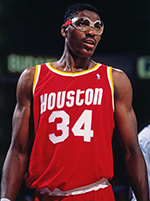 Not many players on the list of NBA legends were as complete as Olajuwon, a native of Nigeria who was the centerpiece of the Houston Rockets’ back-to-back NBA champion teams in 1994 and 1995.
Not many players on the list of NBA legends were as complete as Olajuwon, a native of Nigeria who was the centerpiece of the Houston Rockets’ back-to-back NBA champion teams in 1994 and 1995.
Olajuwon regularly ranked among the league leaders each season in scoring and rebounding, averaging as many as 27.8 points per game (1994-95) and twice leading the NBA in rebounds per contest. The 7-foot center also owns the all-time record for blocks (3,830), topped the league in blocks per game three times in a four-year span from 1989-93, and ranks eighth in NBA history with 2,162 steals.
Much of Olajuwon’s greatness was credited to his excellent footwork, which he developed as a youngster playing soccer. He was nicknamed “Hakeem the Dream” for his ability to maneuver effortlessly around the court despite his size and height, and his “Dream Shake” (a series of fakes and spin moves that mesmerized defenders) made him one of the most difficult players in history to guard in the paint.
Olajuwon remains one of only four players in history to record a quadruple-double, collecting 18 points, 16 rebounds, 11 blocks, and 10 assists in a 1990 game against the Milwaukee Bucks. [ Back to Top ↑ ]
Jerry West
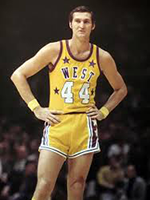 The impact that West had on the NBA is best summed up by the fact that he has essentially been the face of the league for the past 50 years. The silhouette of a player dribbling the basketball in the NBA logo is based on a 1969 photo of West, a fact the league has always been reluctant to confirm but that West himself has sheepishly acknowledged.
The impact that West had on the NBA is best summed up by the fact that he has essentially been the face of the league for the past 50 years. The silhouette of a player dribbling the basketball in the NBA logo is based on a 1969 photo of West, a fact the league has always been reluctant to confirm but that West himself has sheepishly acknowledged.
West’s legacy in the NBA goes far beyond a simple logo, however. The former Lakers guard’s career average of 27.0 points per game ranks fourth among all retired players, and he’s the only player from a losing team ever to be named the most valuable player of the NBA Finals. The dominance of the Celtics throughout the 1960s (10 titles in an 11-year span from 1959-1969) may have limited West to just one NBA championship in his career, but he appeared in the league finals on eight other occasions.
West also dominated the NBA when his playing days were over. He’s won eight league championships as an executive (including four as the general manager of the Lakers), and he guided the Memphis Grizzlies to the franchise’s first playoff appearance within two years of becoming their general manager in 2002. [ Back to Top ↑ ]
Tim Duncan
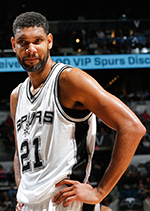 Whether it was his playing style on the court or his quiet persona off it, there was nothing flashy about Tim Duncan. Yet when the long-time Spurs star ended his 19-year NBA career in 2016, former teammates and opponents were both quick to describe him as the best power forward to play the game.
Whether it was his playing style on the court or his quiet persona off it, there was nothing flashy about Tim Duncan. Yet when the long-time Spurs star ended his 19-year NBA career in 2016, former teammates and opponents were both quick to describe him as the best power forward to play the game.
Over the course of Duncan’s tenure in the NBA (spent entirely in San Antonio, ranking him behind only Kobe Bryant for the longest NBA career with just one team), he earned a pair of MVP awards, three NBA Finals MVP trophies, and 15 all-star selections. He also ranks sixth all-time in blocks, seventh in rebounds, 11th in games played, and 17th in points scored.
But the thing that defines the “Big Fundamental” the most was his legacy of winning. His five NBA championships are tied for the most won by any player since 1999, and the 15 years between his first and last NBA title is the second-longest span in history behind only Kareem-Abdul Jabbar. Duncan also joins Kareem and Robert Parish as the only players in history to win more than 1,000 regular-season games, and the Spurs posted a winning percentage of .600 or higher in every single one of his seasons. [ Back to Top ↑ ]
Bob Cousy
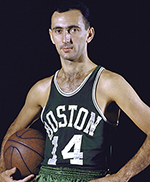 When Cousy was dribbling behind his back or tossing no-look passes to teammates in the 1940s, he was so ahead of his time that even the greatest basketball experts didn’t appreciate his talents. His Holy Cross college coach benched him because he thought Cousy was showboating, and Boston Celtics president Red Auerbach referred to him as a “local yokel” when passing up the chance to draft Cousy in 1950.
When Cousy was dribbling behind his back or tossing no-look passes to teammates in the 1940s, he was so ahead of his time that even the greatest basketball experts didn’t appreciate his talents. His Holy Cross college coach benched him because he thought Cousy was showboating, and Boston Celtics president Red Auerbach referred to him as a “local yokel” when passing up the chance to draft Cousy in 1950.
Cousy’s greatness is certainly appreciated now. Known as the “Houdini of the Hardwood,” the Celtics floor general revolutionized the point guard position with the same razzle-dazzle style that earned him criticism as a youngster. He led the NBA in assists for eight straight years and helped the Celtics dynasty to six of the 10 titles it won in the 1950s and ‘60s. Cousy could also score when he needed to, recording 50 points (including 23 in overtime) in Boston’s quadruple-OT win over the Syracuse Nationals in the 1962 playoffs. [ Back to Top ↑ ]
Oscar Robertson
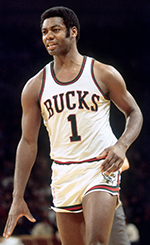 If Cousy revolutionized the point guard position, Robertson completely redefined it. The “Big O” shattered Cousy’s single-season assists record within two years of entering the NBA, and his 6-foot-5, 210-pound frame allowed him to dominate the boards as well.
If Cousy revolutionized the point guard position, Robertson completely redefined it. The “Big O” shattered Cousy’s single-season assists record within two years of entering the NBA, and his 6-foot-5, 210-pound frame allowed him to dominate the boards as well.
Robertson averaged 30.8 points, 12.5 rebounds, and 11.4 assists per game in 1961-62, making him the only player to average a triple-double for an entire season until Russell Westbrook accomplished the feat in 2016-17. The Cincinnati Royals and Milwaukee Bucks standout also went on to become the highest-scoring guard of all time, averaged more than 30 points per game in a season six times, won the NBA title in 1971 with the Bucks, and was the only player other than Wilt Chamberlain or Bill Russell to win the NBA MVP during the eight-season span from 1960-68.
Robertson’s amazing numbers and accomplishments as a pro don’t even begin to tell the entire story of his lasting impact on the sport of basketball. He was the first black player in the history of the University of Cincinnati’s basketball program, overcoming the racist taunts of opposing fans to average 33.8 points per game in his three college seasons, appear in a pair of Final Fours, and lead the Bearcats to an overall record of 79-9. Later as a pro, Robertson presided over the Players Association when the players filed an anti-trust lawsuit in 1970 (known as the Oscar Robertson Rule) that challenged the legality of the college draft and restrictions on free agency, eventually leading to higher salaries for all players.
What makes Robertson’s legacy even more inspirational is the fact that his family couldn’t even afford to buy him a basketball when he was growing up. Decades after learning to shoot by throwing tennis balls or balled-up rags into a peach basket, Robertson continues to be an advocate for African-Americans, focusing on improving living conditions and increasing affordable housing for black people in his hometown of Indianapolis. [ Back to Top ↑ ]
Isiah Thomas
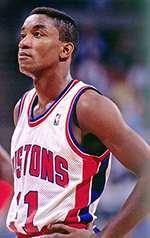 As the diminutive star point guard of the two-time NBA champion Detroit Pistons in the 1980s and early ‘90s, Thomas proved that size isn’t everything in basketball. Though he was barely six feet tall and was routinely giving up six inches of height or more to his opponents, Isiah forged a legendary 13-year NBA career through his toughness, feistiness, and grit.
As the diminutive star point guard of the two-time NBA champion Detroit Pistons in the 1980s and early ‘90s, Thomas proved that size isn’t everything in basketball. Though he was barely six feet tall and was routinely giving up six inches of height or more to his opponents, Isiah forged a legendary 13-year NBA career through his toughness, feistiness, and grit.
Those character traits can be traced back to Thomas’ humble beginnings, growing up as the youngest of nine kids in a single-parent family in one of the poorest areas of Chicago. Despite his difficult childhood, Thomas became known for his never-ending optimism and the ever-present smile on his face. Playing for two years under Bobby Knight at Indiana University, where Thomas led the Hoosiers to the 1981 NCAA championship game, undoubtedly toughened “Zeke” up even more.
Once he arrived in the NBA, Thomas made an immediate impact on a struggling Pistons franchise. He was an all-star in each of his first 12 seasons, his 13.9 assists per game in 1984-85 set an NBA record, he was the fourth player in NBA history to crack the 9,000-assist plateau, and he was the MVP of the 1984 and 1986 All-Star Games. Most notably, he led Detroit to three straight NBA Finals, including victories over the Lakers in 1989 and Trail Blazers in 1990.
Injuries derailed Thomas’ career by age 32, likely due to the physical pounding his body took playing against larger opponents for so many years. In his final season, Thomas suffered a hyperextended knee, broken rib, calf and Achilles tendon injury, and he retired as the Pistons’ all-time leader in points, assists, steals, and games played.
A former president of the NBA Players Association, Thomas has also worked in basketball in several other off-court capacities as well. He’s been the head coach of the Pacers and Knicks, was an executive with the Raptors, co-owned a WNBA team, and is currently a studio analyst for NBA TV. [ Back to Top ↑ ]
Steve Nash
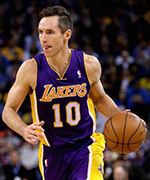 Unlike most NBA legends, Nash was never a young prodigy whose potential for greatness was always apparent. He was born in South Africa, grew up in Canada, was under the radar during his college years at Santa Clara, and was a backup point guard early in his NBA career (playing behind Kevin Johnson and Jason Kidd in Phoenix).
Unlike most NBA legends, Nash was never a young prodigy whose potential for greatness was always apparent. He was born in South Africa, grew up in Canada, was under the radar during his college years at Santa Clara, and was a backup point guard early in his NBA career (playing behind Kevin Johnson and Jason Kidd in Phoenix).
Even after blossoming into a star with the Mavericks in the early 2000s, Nash was not re-signed by Dallas and went back to Phoenix for a second tour of duty with the Suns. Playing in coach Mike D’Antoni’s high-paced attack, Nash’s true potential was finally unlocked. He went on to lead the league in assists in five of his next eight seasons and was named league MVP in 2005 and 2006.
Though he was known most for his creative playmaking and incredible passing, Nash was also a lethal shooter himself. He shot nearly 50% from the field in his career, hit 42.8% of his 3-point shots, and was a 90% shooter from the free throw line. Despite the fact that Nash was never able to take the Suns to the NBA Finals, he’ll always be remembered as the best offensive point guard of the 2000s. [ Back to Top ↑ ]
Allen Iverson
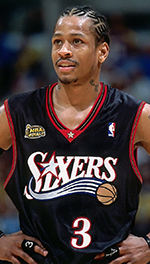 Iverson accomplished many impressive things in his 15-year NBA career. He was a four-time scoring champion, was the league MVP in 2000-01, and was named to 11 all-star teams (twice winning All-Star MVP). He also ranks seventh all-time in regular-season scoring average (26.7 points per game), and his playoff average of 29.7 points per game is second to only Michael Jordan.
Iverson accomplished many impressive things in his 15-year NBA career. He was a four-time scoring champion, was the league MVP in 2000-01, and was named to 11 all-star teams (twice winning All-Star MVP). He also ranks seventh all-time in regular-season scoring average (26.7 points per game), and his playoff average of 29.7 points per game is second to only Michael Jordan.
But the greatest legacy of “The Answer” is how he brought streetball to the professional game. Epitomizing the hip-hop culture with his braids, tattoos, chains, and oversized jerseys, Iverson used a blend of skill, improvisation, and desire to make the most out of his 6-foot frame. His signature crossover dribble was virtually unstoppable, even confounding Michael Jordan when Iverson lit up the Bulls for 37 points as a rookie in 1997.
Simply put, Iverson had no fear. His willingness to literally throw his body across the court made him as dangerous on defense as he was a scorer (Iverson was the back-to-back Big East defensive player of the year in college, and he was a three-time steals leader in the NBA). Iverson also single-handedly carried an undermanned Sixers squad all the way to the 2001 NBA Finals, where his 48-point effort in Game 1 resulted in the only loss of the playoffs for the powerful Lakers. [ Back to Top ↑ ]
Ray Allen
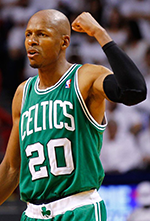 Before the modern era of the NBA put more of a premium and emphasis on the three-point shot, Allen was the greatest long-range shooter the game had ever seen. He retired in 2014 as the NBA’s all-time leader in three-point baskets (both in the regular season and in playoffs), and his eight three-pointers (on 11 attempts) in Game 2 of the 2010 NBA Finals remains the record for the most successful treys in a Finals game.
Before the modern era of the NBA put more of a premium and emphasis on the three-point shot, Allen was the greatest long-range shooter the game had ever seen. He retired in 2014 as the NBA’s all-time leader in three-point baskets (both in the regular season and in playoffs), and his eight three-pointers (on 11 attempts) in Game 2 of the 2010 NBA Finals remains the record for the most successful treys in a Finals game.
Not only did Allen’s quick release and lethal accuracy from behind the three-point line make him ruthlessly efficient, but he also came through when stakes were at the highest. His most memorable shot came in Game 6 of the 2013 Finals, when his game-tying three-pointer with 5.7 seconds left in regulation prevented the Heat from losing the series to San Antonio. Miami went on to win the game in overtime, then beat the Spurs two days later in Game 7. Allen also came up huge in the 2008 Finals with the Celtics, when his 7-for-9 performance from behind the arc in Game 2 catapulted Boston to victory that night, and eventually, the NBA championship. [ Back to Top ↑ ]
Dwyane Wade
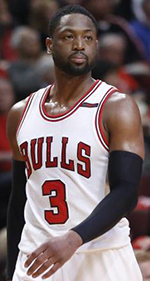 If Wade does decide to hang up his shoes after the 2018 season (at the time of writing, he had hinted at retirement but hadn’t officially made a decision), he’ll go down in history as one of the greatest shooting guards to ever play in the NBA.
If Wade does decide to hang up his shoes after the 2018 season (at the time of writing, he had hinted at retirement but hadn’t officially made a decision), he’ll go down in history as one of the greatest shooting guards to ever play in the NBA.
His career statistics may not be overwhelming (23.8 points per game, 4.9 rebounds, 5.8 assists), but Wade was the consummate team player. He sacrificed offensive numbers to mesh with fellow superstars such as Shaquille O’Neal and LeBron James, prioritizing the pursuit of winning championships over individual accolades. His value as an all-around contributor is better illustrated by the fact he is one of only six players (as of 2018) to record 20,000 points, 4,000 rebounds, 4,000 assists, 1,500 steals, and 800 blocks.
Even if he ends up being most remembered for winning a pair of titles with LeBron and Chris Bosh in the early 2010s, Wade’s MVP performance in the 2006 NBA Finals should be his lasting legacy. He averaged nearly 35 points, eight rebounds, four assists, three steals, and one block per game in that series, leading the Heat from a 2-0 series deficit (and a 13-point deficit in Game 3) to a six-game victory over the Mavericks. [ Back to Top ↑ ]
Shaquille O’Neal
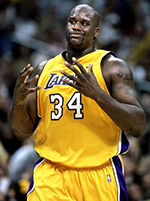 The way that the 7-foot-1, 325-pound Shaq dominated the paint throughout his 19-year career may never be seen again. Defenses were so overmatched by the Big Diesel that many of them simply resorted to the Hack-a-Shaq strategy, intentionally fouling him and sending him to the free throw line instead of trying to stop him.
The way that the 7-foot-1, 325-pound Shaq dominated the paint throughout his 19-year career may never be seen again. Defenses were so overmatched by the Big Diesel that many of them simply resorted to the Hack-a-Shaq strategy, intentionally fouling him and sending him to the free throw line instead of trying to stop him.
Although he was one of the heaviest men to ever play in the NBA, O’Neal was remarkably light on his feet and had an adept touch around the basket. His career field goal percentage of 58.2% is the third-highest in NBA history, and he also finished his career eighth in all-time scoring, sixth in field goals made, eighth in blocks, and 14th in rebounds. The height of his stardom came with the Lakers, with whom he won three consecutive NBA titles from 2000-2002, although he added another league championship to his mantle in 2006 with the Heat.
As seriously as he took the game, however, Shaq also knew how to have fun. He referred to himself as “The Big Aristotle” during interviews, famously nicknamed the Sacramento Kings as the “Queens,” produced his own rap music, appeared in several movies, and even participated in a professional wrestling match at Wrestlemania 32. He remains one of the game’s most loved and adored figures through his work with the NBA on TNT. [ Back to Top ↑ ]
Dirk Nowitzki
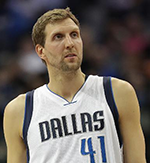 Nowitzki was still an active player at the time of writing, but he’s already easily entrenched himself as the greatest basketball player ever from a European nation. The 7-foot German also changed the way that NBA teams approached the power forward position, paving the way for the stretch-4s and even stretch-5s that we see in the league today.
Nowitzki was still an active player at the time of writing, but he’s already easily entrenched himself as the greatest basketball player ever from a European nation. The 7-foot German also changed the way that NBA teams approached the power forward position, paving the way for the stretch-4s and even stretch-5s that we see in the league today.
Nowitzki’s combination of length, shooting accuracy, and ball handling skills made him an impossible mismatch for opposing perimeter defenders. If they got too close to him, he had the ability to dribble by them and drive to the basket, a rare ability for men his size. If they backed too far off him, he shot the three-pointer at nearly 40% efficiency. And even if they defended him well, Nowitzki could simply pull out “The Dirk,” his signature one-legged fadeaway shot that was essentially unguardable.
Assuming that Nowitzki avoids injury for at least one more full season, he looks certain to pass Wilt Chamberlain for fifth on the NBA career scoring list and could even overtake Michael Jordan for fourth all-time. He’s also the only player in league history to collect 31,000 points, 10,000 rebounds, 3,000 assists, 1,000 blocks, 1,000 steals, and 1,000 three-pointers in his career. [ Back to Top ↑ ]
James Worthy
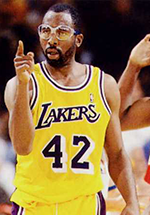 Fans may not have fully appreciated Worthy’s value during his playing days, but his teammates certainly did. Even though the small forward was never the most celebrated superstar on his team (even in college at North Carolina, where he played in the shadow of Michael Jordan), Worthy earned the nickname “Big Game James” for his uncanny ability to elevate his game when things mattered most.
Fans may not have fully appreciated Worthy’s value during his playing days, but his teammates certainly did. Even though the small forward was never the most celebrated superstar on his team (even in college at North Carolina, where he played in the shadow of Michael Jordan), Worthy earned the nickname “Big Game James” for his uncanny ability to elevate his game when things mattered most.
Worthy’s big-game reputation dates back to the 1982 NCAA Tournament, when he shot 13-for-17 in the national title game and was named the Final Four’s Most Outstanding Player. He continued to come up big when he reached the pros, helping the Lakers to three championships in the 1980s – including the 1988 Finals, when his triple-double in Game 7 against Detroit earned him Finals MVP honors.
Although Worthy always seemed to save his best for the playoffs, he was also a stellar regular-season performer. He shot 53% or better from the field in each of his first eight seasons, he earned seven consecutive all-star selections at one point in his career, and he averaged 20-plus points in four seasons.
Kareem Abdul-Jabbar and Magic Johnson may have stolen the spotlight from Worthy during his time with the Lakers, but LA head coach Pat Riley told the Los Angeles Daily News in 1994 that “I don’t think there has been or will be a better small forward than James.” [ Back to Top ↑ ]
Pete Maravich
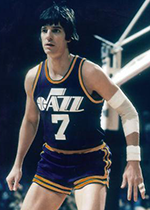 Whether it was the lack of success of the teams he played on, the era in which he played, or the sudden heart attack that claimed his life at the age of 40, “Pistol” Pete Maravich is the most tragic figure of all NBA legends.
Whether it was the lack of success of the teams he played on, the era in which he played, or the sudden heart attack that claimed his life at the age of 40, “Pistol” Pete Maravich is the most tragic figure of all NBA legends.
Maravich lit up the scoreboard wherever he played, beginning in college where he still ranks as the all-time leading scorer in NCAA history. He averaged 43 points or more in each of his three years at LSU, highlighted by a senior campaign in which he scored 50-plus points in 10 of 31 games and was named the college player of the year. Yet LSU could only manage a 49-35 record with Maravich in the lineup, leading to criticism that he was a selfish player who didn’t put the team first.
That reputation followed Maravich into the pros. Although the Pistol was ninth in the league in scoring as a rookie in 1970 with Atlanta, he and the Hawks never won a playoff series during his four-year stint in Georgia. Following a trade to the expansion New Orleans Jazz that returned him to the state where he starred in college, Maravich continued to put up big offensive numbers (including the league scoring title in 1976-77) but was never able to lead the Jazz to the postseason.
Maravich’s career average of 24.2 points per game would have been even higher had the league implemented the three-point shot earlier in his career. Many of Maravich’s baskets came on long jumpers that would have been threes, but the NBA didn’t add the three-point line until Maravich’s final season.
Knee problems forced Maravich into retirement at the young age of 32. Sadly, he died eight years later from a heart attack while playing a pickup game of 3-on-3 basketball. [ Back to Top ↑ ]
Bill Walton
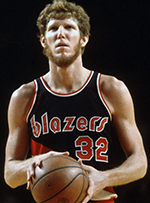 Walton may seem like a curious inclusion on this list, considering that his career statistics don’t compare at all with the numbers put up by other NBA legends. After all, the center averaged just 13.3 points per game throughout his 11-year career, and his 4,923 rebounds don’t even rank him among the top 250 of all time.
Walton may seem like a curious inclusion on this list, considering that his career statistics don’t compare at all with the numbers put up by other NBA legends. After all, the center averaged just 13.3 points per game throughout his 11-year career, and his 4,923 rebounds don’t even rank him among the top 250 of all time.
But Walton’s numbers need to be taken with a major grain of salt, due to a myriad of injuries that forced him to miss more than half of his team’s games throughout his career. When Walton was healthy enough to play, he played at a level that few other centers have been able to match in NBA history.
The best glimpse we ever got of Walton’s true potential came in his college days at UCLA, where he was a three-time national player of the year and shot 21-for-22 in the 1973 NCAA championship game against Memphis State. Even then, Walton was plagued by multiple injuries, but those injuries became much more severe and regular when he reached the pros. Walton missed more than 80 games in his first two campaigns with the Trail Blazers, and a chronically broken bone in his left foot forced him to sit out three entire seasons before he turned 30.
In one of the few seasons that Walton went relatively unscathed by injuries, he led the Trail Blazers to the 1977 NBA championship, earning Finals MVP honors in the process. The following year, Walton was crowned the league MVP despite playing in just 58 games, averaging 18.9 points, 13.2 rebounds, 5 assists, and 2.5 blocks.
After battling even more injuries (including a broken ankle in the 1978 playoffs that led to a malpractice lawsuit against the Blazers and forced a trade to the San Diego Clippers), Walton finished his career coming off the bench for the Celtics. Despite playing less than 20 minutes per game, Walton still averaged nearly eight points and seven rebounds per game, claiming the NBA’s Sixth Man Award and helping Boston win the 1986 championship.
Ironically, despite having a combative relationship with the media during his days at UCLA and Portland, Walton later became one of the most beloved and revered TV commentators in NBA history. [ Back to Top ↑ ]
Moses Malone
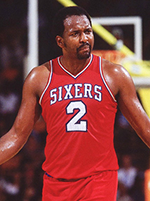 No one in NBA history was as unstoppable on the offensive glass as Malone. Though he wasn’t as big as many of the other legendary centers in basketball, the long-time Sixers star relied on strength and quickness to pull down the most offensive rebounds of all time. He also holds the record for most offensive rebounds in one game (21, set in 1982 against Seattle), as well as the four highest single-season offensive rebound totals in history.
No one in NBA history was as unstoppable on the offensive glass as Malone. Though he wasn’t as big as many of the other legendary centers in basketball, the long-time Sixers star relied on strength and quickness to pull down the most offensive rebounds of all time. He also holds the record for most offensive rebounds in one game (21, set in 1982 against Seattle), as well as the four highest single-season offensive rebound totals in history.
The first basketball player in history to go straight from high school to the pros (Malone spent two seasons with the ABA’s Utah Stars before going to the NBA), Malone went on to become a three-time league MVP, led the Houston Rockets to the 1981 Finals, and was part of the Sixers’ 1983 championship team that lost just one game in the playoffs.
Malone was also a dominant scorer (ranking sixth in all-time scoring when he retired) and defensive player. He still holds the record for most consecutive games played without fouling out (1,212) and is second all-time to Karl Malone for most free throws made in a career. [ Back to Top ↑ ]
Karl Malone
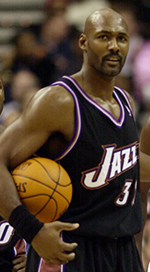 There may have been no better nickname in basketball history than “The Mailman” moniker that was assigned to Malone during his college years at Louisiana Tech. Throughout a 19-year career that was mostly spent with the Utah Jazz, Malone consistently delivered scoring, rebounding, and defense, setting a new standard for production from the power forward position.
There may have been no better nickname in basketball history than “The Mailman” moniker that was assigned to Malone during his college years at Louisiana Tech. Throughout a 19-year career that was mostly spent with the Utah Jazz, Malone consistently delivered scoring, rebounding, and defense, setting a new standard for production from the power forward position.
Highlights of Malone’s career include 11 straight seasons in which he averaged 25 points or more, two league MVP awards, two appearances in the NBA Finals (losing to Michael Jordan’s Bulls in both 1997 and 1998), making the most free throws in NBA history, and finishing as the second-highest scorer of all time. Malone and teammate John Stockton remain the gold standard for how the pick-and-roll offense should be played in the half court.
Although Malone holds the dubious record for the most playoff games lost by an individual player (95), that number is a testament to how consistently his Jazz went deep into the postseason. Malone was also legendary for his durability, missing just 10 games in his 18 seasons in Utah before concluding his career with a one-year stint with the Lakers in 2003-04. [ Back to Top ↑ ]
John Stockton
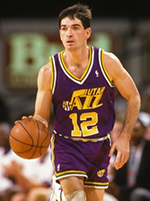 Though Stockton’s name will always be intertwined with Karl Malone’s for how dominantly the two players ran the pick-and-roll attack for nearly two decades in Utah, the point guard is more than deserving of his own place in NBA history.
Though Stockton’s name will always be intertwined with Karl Malone’s for how dominantly the two players ran the pick-and-roll attack for nearly two decades in Utah, the point guard is more than deserving of his own place in NBA history.
A true basketball throwback, whether it was how he played point guard or how he continued to
wear short shorts after the rest of the league switched to long and baggy, Stockton was as pure a set-up man as the NBA has ever seen. Not only does Stockton hold the career record for most assists, but his 15,806 helpers are also nearly 4,000 more than the next player (Jason Kidd) on that list. He led the league in assists for nine straight years at one point in his career, and his 24 assists in a 1988 playoff game against the Lakers is tied for the most in one postseason contest.
Stockton’s willingness to defer to Malone and other teammates belied his own shooting abilities. The .515 field goal percentage he posted in his career ranks 73rd all-time in the NBA, but nearly every player ahead of Stockton in that category played forward or center, where shot attempts are typically closer to the basket. His signature shot was a three-pointer hit over Houston’s Charles Barkley in Game 6 of the 1997 Western Conference championship series, giving the Jazz a last-second win and advancing Utah to its first of back-to-back NBA Finals appearances.
Stockton also excelled at the defensive end of the floor, where he recorded the most steals in NBA history, and never hesitated to set a physical pick against larger opponents in order to free up his teammates. He and Malone clearly belong on any short list of the best NBA players never to win a championship. [ Back to Top ↑ ]
Jason Kidd
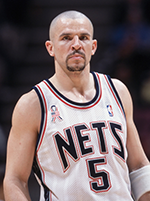 Kidd’s lasting legacy in the NBA is as a player who would (and could) do whatever it took for his team to win. He’s second on the all-time assist list with 12,091 dimes, his 107 career triple-doubles were the third-most in NBA history when he retired in 2013, and he’s the only player in history to record 15,000 points, 10,000 assists, and 7,000 rebounds.
Kidd’s lasting legacy in the NBA is as a player who would (and could) do whatever it took for his team to win. He’s second on the all-time assist list with 12,091 dimes, his 107 career triple-doubles were the third-most in NBA history when he retired in 2013, and he’s the only player in history to record 15,000 points, 10,000 assists, and 7,000 rebounds.
What stuck out most about Kidd, however, was how he evolved his game throughout his career in order to fit in with what his team needed the most. When he first came into the league as a 21-year-old with the Mavericks in 1994, Kidd was a high-risk, high-reward passer who struggled badly with his shot. Later in his career in Phoenix and New Jersey, Kidd became a more conservative and fundamentally-sound decision maker, improved his jumper to the point where opponents had to guard him, and also developed into a solid defender. By the end of his career, Kidd’s all-around contributions enabled him to win his first NBA championship, helping the Mavericks to the 2011 title. [ Back to Top ↑ ]
Rick Barry
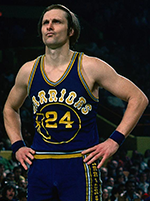 Whether it was in college, the ABA, or the NBA, Barry was one of the top scorers of his generation. The forward is the only player in basketball history to win a season scoring title in each of those leagues, and his 25,279 points in the ABA and NBA combined ranks 23rd on the all-time list. Barry averaged more than 30 points per game in four different seasons as a pro, and he led an otherwise-average San Francisco Warriors squad to the 1975 NBA championship with a Finals MVP performance.
Whether it was in college, the ABA, or the NBA, Barry was one of the top scorers of his generation. The forward is the only player in basketball history to win a season scoring title in each of those leagues, and his 25,279 points in the ABA and NBA combined ranks 23rd on the all-time list. Barry averaged more than 30 points per game in four different seasons as a pro, and he led an otherwise-average San Francisco Warriors squad to the 1975 NBA championship with a Finals MVP performance.
Barry will also be remembered as being arguably the most controversial player of his era.
His outspoken nature rubbed fans, media, and even teammates the wrong way at times, and he was the first legitimate superstar to leave the NBA for the ABA. Within one season of defecting to the ABA, he unsuccessfully attempted to move back to the NBA after the Oakland Oaks moved to Washington. Several years later, when he seemed content in the ABA with the New York Nets, a court decision forced him to return back to the NBA’s Warriors.
Barry’s four years in the ABA, where his teams didn’t have the strongest supporting casts, forced him to develop his all-around game. He was a much better passer and defender in his second NBA tenure, ranking among the top 10 players in the league in assists on several occasions. Finally, Barry’s unique underhanded free-throw shooting style (popularly known as a Granny Shot) helped him top the league in free throw percentage for six straight years and finish his career with a success rate above 90% from the charity stripe. [ Back to Top ↑ ]
Dominique Wilkins
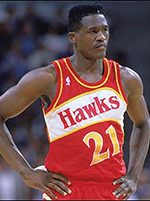 Known throughout the 1970s and ‘80s as the “Human Highlight Film” for his incredible athleticism and spectacular dunks, Wilkins is still considered by many as the greatest dunker of all time.
Known throughout the 1970s and ‘80s as the “Human Highlight Film” for his incredible athleticism and spectacular dunks, Wilkins is still considered by many as the greatest dunker of all time.
The long-time Atlanta Hawks star was a two-time champion of the NBA Slam Dunk Contest, and he was the runner-up on two other occasions. His loss to Michael Jordan in the final of the 1988 dunk contest was one of the most controversial decisions in the history of the event, with allegations that Jordan received favoritism from judges since the competition was held in Chicago.
Although he was best known for his signature windmill dunks, Wilkins could also score in a variety of other acrobatic ways. The 6-foot-8 forward won the 1986 scoring title with an average of 30.3 points per game, and he finished second in the league with 29.9 points per game in 1991-92, one year after he ruptured his Achilles tendon. When Wilkins retired in 1999, he was the seventh-highest scorer in league history. [ Back to Top ↑ ]
Elgin Baylor
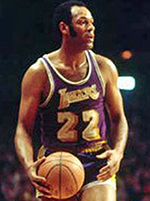 The only thing that prevented Baylor from being an even bigger star was the era in which he played. Not only was Baylor’s acrobatic style not exposed to television viewers the way that the NBA is showcased today, but his 14-year career also coincided with the Boston Celtics dynasty and Wilt Chamberlain’s domination throughout the 1960s.
The only thing that prevented Baylor from being an even bigger star was the era in which he played. Not only was Baylor’s acrobatic style not exposed to television viewers the way that the NBA is showcased today, but his 14-year career also coincided with the Boston Celtics dynasty and Wilt Chamberlain’s domination throughout the 1960s.
Though he posted the third-highest scoring average in NBA history and averaged more than 34 points in three straight seasons, Baylor never won a scoring title. And although he appeared in eight NBA Finals and scored 61 points in Game 5 of the 1962 Finals, Baylor never won a championship with the Minneapolis and Los Angeles Lakers.
The 6-foot-5 small forward was never considered to be a terrific jumper, but he found creative ways to score by relying on his hang time to make reverse layups and double-pump jumpers. Baylor also filled the stat sheet in several other categories, particularly in 1962-63 when he became the first player to finish a season in the top five of the league in scoring, rebounds, assists, and free throw percentage.
Unfortunately for Baylor, knee injuries slowed him down in the twilight of his career, and he eventually retired early in the 1971-72 season. Ironically, the Lakers went on to win the title later that year without him. [ Back to Top ↑ ]
Kevin Garnett
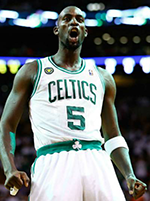 Beginning in 1995 when he was the first player in two decades to go straight from high school to the NBA, “The Big Ticket” was arguably the most intense and menacing two-way big man in basketball for the next 20 years.
Beginning in 1995 when he was the first player in two decades to go straight from high school to the NBA, “The Big Ticket” was arguably the most intense and menacing two-way big man in basketball for the next 20 years.
The slender but imposing forward was named an NBA All-Star in his sophomore season with the Timberwolves, he was crowned league MVP in 2003-04, and he averaged over 20 points and 10 rebounds per game in his final nine campaigns in Minnesota. But his career didn’t fully take off until 2007 when, after failing to win a playoff series in each of his first seven postseason trips with the Wolves, Garnett orchestrated a trade to the Boston Celtics.
That season, Garnett and fellow newcomer Ray Allen helped the Celtics make the biggest single-season improvement in NBA history, culminating in the 2008 NBA championship. K.G. was brilliant offensively throughout that playoff run, averaging 20.4 points per game and shooting 49.5% from the field. But the rebounding, tenacity, and leadership provided by the defending Defensive Player of the Year might have been even more valuable for a Celtics squad that had to go seven games in each of its first two series wins before winning its last two series in six.
Garnett also loved to intimidate opponents, whether it was jumping to swat away jumpers after a whistle or physically bullying smaller foes. But he’ll always be celebrated as one of the elite defenders of his time, evidenced by his 12 all-defensive team nominations and his ownership of the all-time record for defensive rebounds. [ Back to Top ↑ ]
Charles Barkley
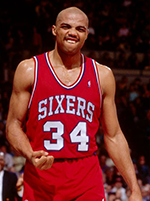 When Barkley came out of Auburn University in 1984, not many would have ever imagined he would eventually become one of the greatest power forwards in NBA history. At 6-foot-4 and with a stocky build, the man known as “The Round Mound of Rebound” was projected to be nothing more than a solid rebounder and average offensive contributor.
When Barkley came out of Auburn University in 1984, not many would have ever imagined he would eventually become one of the greatest power forwards in NBA history. At 6-foot-4 and with a stocky build, the man known as “The Round Mound of Rebound” was projected to be nothing more than a solid rebounder and average offensive contributor.
However, Sir Charles’ unique blend of speed, power, skill, and determination helped make him a perennial All-Star. His greatest season came in 1992-93 when he was named league MVP in his first season with Phoenix, then catapulted the Suns into the NBA Finals by scoring 44 points and pulling down 24 rebounds in Game 7 of the Western Conference championship series. Even though Barkley’s career was later derailed by back and knee injuries, he joined Kareem Abdul-Jabbar, Wilt Chamberlain, and Karl Malone as the only players to ever record 20,000 points, 10,000 rebounds, and 4,000 assists.
Barkley could be contentious at times, known for committing hard fouls on the court (including a flagrant foul on Hakeem Olajuwon in the dying seconds of a 1994 playoff game) as well as getting in trouble off it. But although his involvement in a barroom brawl might have led to his trade from Philadelphia in 1992, Barkley also displayed a soft side throughout his career. When his attempt to spit on a heckler accidentally hit a young girl instead, he ended up befriending the girl and her family, and he also allowed Scott Brooks to board with him when he was a young rookie.
Barkley’s fun-loving personality and outspoken nature has made him a tremendous hit after his playing career as well, serving as a studio analyst for TNT’s NBA coverage since 2000. [ Back to Top ↑ ]
Steph Curry
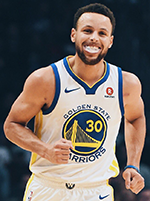 Of all the players who were still in their prime when this article was written (Kevin Durant, Russell Westbrook, and James Harden, to name a few), Curry stands out the most as the single player who has already left a massive impact on the game.
Of all the players who were still in their prime when this article was written (Kevin Durant, Russell Westbrook, and James Harden, to name a few), Curry stands out the most as the single player who has already left a massive impact on the game.
The son of former three-point specialist Dell Curry, Steph took the trey to a whole new level and changed the way offense is played in the NBA, possibly forever. His career 43.6% success rate from behind the arc (as of 2018) may rank second all-time to his Golden State coach, Steve Kerr, but the high volume of Curry’s attempts and his ability to create his own shot make him the most lethal three-point sniper in NBA history. Curry was crowned league MVP in 2015 after leading Golden State to its first title since 1975, then became the first unanimous MVP in league history the following season.
The success of the 6-foot-3, 190-pound guard also serves as inspiration to any youngsters who have ever been declared to be too small or too short to excel in basketball. And considering that the Baby-Faced Assassin had yet to turn 30 at the time this article was written, his best may still be to come. [ Back to Top ↑ ]
Reggie Miller
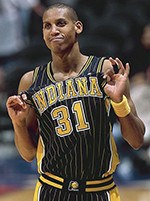 In addition to being one of the best three-point shooters in NBA history, Miller will also be remembered as being among the most clutch players to ever take the hardcourt.
In addition to being one of the best three-point shooters in NBA history, Miller will also be remembered as being among the most clutch players to ever take the hardcourt.
Throughout his 18-year career with the Pacers from 1987-2005, Miller never shied away from the spotlight. His penchant for hitting huge shots at the biggest moments of games led to the final stretch of tight games becoming simply known as “Miller Time.”
Miller’s favorite victim was the New York Knicks, especially in postseason play where the teams repeatedly butted heads throughout the 1990s. In Game 5 of the 1994 Eastern Conference Finals, Miller scored 25 points in the fourth quarter alone (going 5-for-5 on three-pointers) to lead the Pacers to a comeback victory at Madison Square Garden, all while antagonizing Knicks super fan Spike Lee with a choking gesture. The following year, Miller one-upped that performance by scoring eight points in the final 8.9 seconds to beat the Knicks in Game 1 of the Eastern Conference semis.
Moments like that made Miller the most beloved NBA player in Indiana, even though Pacers fans actually booed their team’s selection of Miller in the 1987 draft, hoping for Indiana Hoosiers star guard Steve Alford instead. Miller, who was born with a hip deformity that caused doctors to wonder if he’d ever walk properly and force him to wear corrective leg braces until the age of four, retired as the most accurate three-point shooter in NBA history, a mark that was later eclipsed by Ray Allen.
Miller remains involved in basketball today as a popular analyst for TNT’s NBA coverage as well as the NCAA Tournament. [ Back to Top ↑ ]
It’s Your Turn to Weigh In
As we mentioned off the top, we made an effort to be as judicious as possible when coming up with this list of NBA legends. In doing so, many great players went unmentioned in this article, including some of the league’s brightest contemporary stars.
Now is your opportunity to weigh in with your opinion. Which players didn’t make our cut that deserve mention among the NBA’s greatest legends of all time? Which players are on here that you feel don’t belong? More importantly, why do you feel that way?
Let us know below…